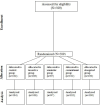Using Games to Simulate Medication Adherence and Nonadherence: Laboratory Experiment in Gamified Behavioral Simulation
- PMID: 39316506
- PMCID: PMC11444231
- DOI: 10.2196/47141
Using Games to Simulate Medication Adherence and Nonadherence: Laboratory Experiment in Gamified Behavioral Simulation
Abstract
Background: Medical nonadherence is a significant problem associated with worse clinical outcomes, higher downstream rehospitalization rates, and a higher use of resources. To improve medication adherence, it is vital for researchers and practitioners to have a solid theoretical understanding of what interventions are likely to work. To achieve this understanding, we propose that researchers should focus on creating small-scale laboratory analogs to the larger real-world setting and determine what interventions, such as nudges or incentives, work to change behavior in the laboratory. To do this, we took inspiration from the literature on serious games and gamification and experimental economics. We call our approach "gamified behavioral simulation." In this paper, we modeled everyday life as the state of being engaged in a simple but addictive game, illness as being interruptions to the functionality of that game, treatment as being a series of actions that can be taken to prevent or mitigate those interruptions, and adherence as sticking to a prescribed rule for the application of those actions.
Objective: This study carries out a behavioral diagnosis of the medication adherence problem through a theoretically informed framework and then develops the gamified behavioral modeling approach to simulate medication nonadherence.
Methods: A laboratory experiment was conducted using a modified popular and addictive open-source video game called "2048," which created an abstract model for the medication adherence behavior observed in real life. In total, 509 participants were assigned to the control and 4 intervention groups ("incentive" group, "reminder" group, "commitment device" group, and "elongated duration for symptoms" group).
Results: The results of the modeling experiment showed that having theoretically informed interventions can increase the likelihood for them to be successful. In particular, there is evidence that the use of reminders improves the medication adherence rates for patients, and the same result was found in the modeling experiment, as they improved adherence significantly by 23% (95% CI -33.97% to -11.72%; P<.001). However, providing an incentive did not improve the adherence rate. We also tested the use of commitment devices, which, in line with real-world evidence, did not improve adherence rates. The fourth treatment tested elongated duration for symptoms, which attempted to show the power of modeling experiments where we test a what-if scenario that is extremely difficult to test in a real setting. The results indicated that if symptoms last longer, people did not adhere more to their medication regimen.
Conclusions: Gamified behavioral simulation is a useful tool to explain real health behaviors and help in identifying which interventions are most likely to work in a randomized trial.
Keywords: antibiotics; behavior change; clinical outcome; devices; diagnosis; experimental modeling; games; gamification; medication; medication adherence; simulate; symptoms; testing behavior; tool.
© Umar Taj, Aikaterini Grimani, Daniel Read, Ivo Vlaev. Originally published in JMIR Serious Games (https://games.jmir.org).
Conflict of interest statement
Figures
References
-
- Chaudri NA. Adherence to long-term therapies: evidence for action. Ann Saudi Med. 2004 Jun 3;24(3):221–222. doi: 10.5144/0256-4947.2004.221. doi. - DOI
-
- Horne R, Weinman J, Barber N, et al. Concordance, adherence and compliance in medicine taking. Association of Health Professions in Ophthalmology. Dec, 2005. [21-07-2022]. https://www.ahpo.net/assets/NCCSDO%20Compliance%202005.pdf URL. Accessed.
LinkOut - more resources
Full Text Sources
Miscellaneous


